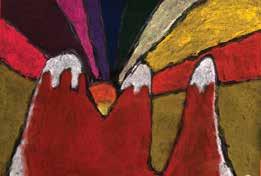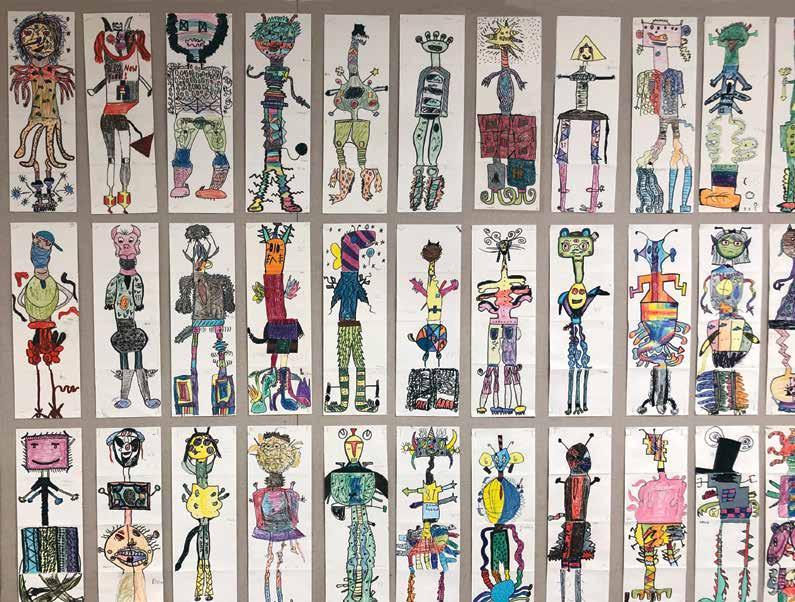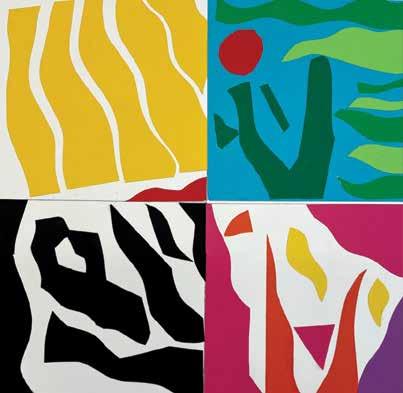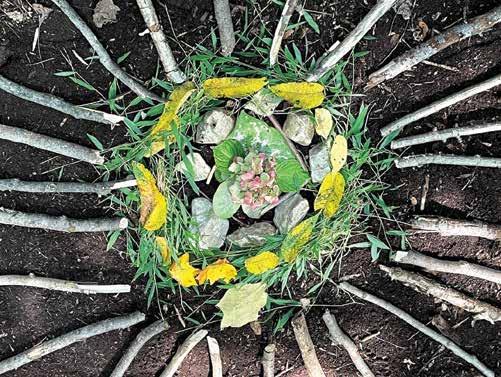
4 minute read
THE ARTS
CRAFTY CREATIONS IN THE
LOWER SCHOOL
Top row: The second grade art class used a bottle of glue to draw a landscape on black paper. Once the glue dried, students used pastels to create colorful landscapes. From left to right is work by Emma Mowatt ’32, Clara Neal ’32, and Arianna Jo ’32.
Bottom row: Fifth grade students completed a collaborative game, “Exquisite Corpse.” The project requires each student to take a turn drawing on a sheet of paper, folding it to their contribution, and then passing it to the next player for a further contribution. The game gained popularity in the 1920s when it was adopted as a technique by artists of the Surrealist movement to generate collaborative compositions.



ARTISTIC EXPRESSION IN THE
MIDDLE SCHOOL
Top row: The study of positive and negative shape interaction culminated with a cut paper project for eighth grade students. On the left is a work by Kaitlyn Hill ’26 and on the right is a work by Michael Rymut ’26.
Bottom row: Sixth and seventh grade students collaborated on works of art that explored the concept of Nature Designs, influenced by the artist Andy Goldsworthy. On the left is work by Austin Yang ’28, Landon Chappell ’28, Jordan Spence ’28, and Colin Goebel ’28. On the right is work by Connor Grimes ’27, Maya Parent ’27, Chloe Hopkins ’27, and Zoe Taylor ’27.




FACULTY SPOTLIGHT Karis Nichols
Karis Nichols’ journey to Glenelg Country School was her answered prayer.
PLEASE GIVE US SOME BACKGROUND ON YOURSELF AND YOUR EXPERIENCE.
I was born in Huntingdon, England, but I’ve spent most of my life in the Midwest! I grew up in a small town, which allowed me to try everything. I eventually found my home on the stage while taking dance and piano lessons, singing in various choirs, and participating in theatre with my two younger brothers. I met my husband in Manhattan, KS, affectionately known as “The Little Apple,” while we were both students at Kansas State University. While he finished up his Ph.D. in nuclear engineering, I taught public school, co-founded a children’s choir, and got my master’s in music education. My husband and I feel blessed to be welcomed so sincerely to Maryland and into the GCS family.
WHY TEACHING?
What I most enjoy about teaching music is with who I’m able to create the music. For me, teaching comes down to investing in students by listening and getting to know them. I love helping students develop a love for the music they can explore throughout their lives. The arts get to the heart of humanity and builds a community of our souls. I feel privileged to serve students and their families in this capacity. No one else in my family was in education, but my love for music and connecting to people led me down this path, one that I find immensely satisfying.
WHAT BROUGHT YOU TO GCS?
Last winter, my husband was offered a great job with the Department of Energy, and we began praying for discernment regarding our next move. The Upper School choir position posted in March was an answer to prayer, and after I accepted it, we saw many other elements of our relocation quickly fall into place more smoothly than we could have hoped.
WHAT IS ONE OF THE MOST REWARDING MOMENTS AS A TEACHER?
I learned a crucial lesson during my first year of teaching. Due to low reading and math scores and frequent trips to the principal’s office, a particularly challenging sixth-grade boy was frequently pulled out of my class. On the days he had the privilege of joining his class in music, he was weeks behind and easily discouraged. Not knowing where to begin for him, I spent only two minutes each class giving him individual encouragement and coaching while the others warmed up and tuned. He seemed indifferent to our time together, and I felt that my efforts were probably wasted but kept it up out of habit and having no other good ideas for how to engage with him. At the end of the year, he slipped a wrinkled scrap of paper onto my music stand that read, “Thanks for not giving up on me.” He sang in my choir every year since with no behavior problems. It’s not about grandiose gestures, but more often, it’s the small, consistent encouragement that genuinely makes a difference.
HOW HAS THE PANDEMIC CHANGED YOUR APPROACH TO TEACHING? ANY ADVANTAGES?
The uncertainty of teaching in the pandemic forced me to think more creatively about engaging students in choral singing. I most enjoyed virtually opening my classroom to other artists, composers, conductors, and performers. My students and I learned the most from having a Zoom clinic with the composer for one of our pieces, and he gave us insight into the music we otherwise would never have gained. It was a huge success and something I hope continues as we return to normal.
WHAT ADVICE DO YOU HAVE FOR STUDENTS LEARNING IN A PANDEMIC?
Have grace for not only your teachers, parents, and other classmates, but also yourself. Things have been challenging but take time to celebrate the little victories as we reintegrate with each other.






